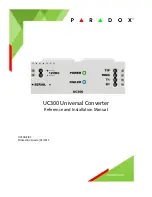
User’s Guide ADI-2/4 Pro SE – v 1.0
77
Now it should be clear why the above advice can be quite important even for an ADI-2/4 Pro SE.
In Multi-channel mode the numbers are even higher:
Base
48 kHz
96 kHz
192 kHz/DSD64
384 kHz/DSD128 768 kHz/DSD256
Channels
8
16
32
64
128
Although on the edge, 384 kHz would work. But 768 kHz - no way. As the ADI-2/4 Pro SE should
work under iOS as well, which has a system limit in transfer bandwidth, its USB transfer mode is
limited to 192 kHz in Multi-channel mode. Fortunately that is no real limitation. The additional
digital I/Os activated then do not support higher sample rates than 192 kHz anyway.
But once again it must be noted: at 192 kHz the USB interface is challenged with data amounts
equalling 32 audio channels transfer, although only 8 are in use.
34.4 M/S Processing
The mid/side principle is a special positioning technique for microphones, which results in a mid
signal on one channel and a side signal on the other channel. This information can be transformed
back into a stereo signal quite easily. The process sends the monaural mid channel to left and
right, the side channel too, but phase inverted (180°) to the right channel.
For a better understanding: the mid channel represents the function L+R, while the side channel
represents L-R.
During record the monitoring needs to be done in 'conventional' stereo. Therefore the ADI-2/4 Pro
SE also offers the functionality of a M/S-decoder. Activation is done in the Settings panel of the
Hardware I/Os via the option
M/S-Proc
.
The M/S-Processing automatically operates as M/S encoder or decoder, depending on the source
signal format. When processing a usual stereo signal, all monaural information will be shifted into
the left channel, all stereo information into the right channel. Thus the stereo signal is M/S en-
coded. This yields some interesting insights into the mono/stereo contents of modern music pro-
ductions.
Additionally some very interesting methods of manipulating the stereo base and generating stereo
effects come up, as it is then very easy to process the side channel with Low Cut, Expander,
Compressor or Delay. Looping this effect chain back into the DAW via AD-conversion often a
transformation back to stereo is missing. That's one of the reasons the ADI-2/4 Pro SE offers
M/S-Proc also in its analog input channels.
The other application is to split a single analog channel signal to both analog inputs, then activate
M/S-Processing and analyze the digital left channel only. This method performs mono summing,
which raises the ADI's incredible SNR by another 3 dB for even better measurement analysis
capabilities.
But the most popular application in music recording is the manipulation of the stereo width: a
change of the level of the side channel allows to manipulate the stereo width from mono to stereo
up to extended (this feature requires an external mixer).
Summary of Contents for ADI-2 Pro
Page 18: ...18 User s Guide ADI 2 4 Pro SE v 1 0...
Page 51: ...User s Guide ADI 2 4 Pro SE v 1 0 51 User s Guide ADI 2 4 Pro SE Inputs and Outputs...
Page 66: ...66 User s Guide ADI 2 4 Pro SE v 1 0...
Page 69: ...User s Guide ADI 2 4 Pro SE v 1 0 69 User s Guide ADI 2 4 Pro SE Technical Reference...
Page 92: ...92 User s Guide ADI 2 4 Pro SE v 1 0 34 16 Loudness 34 17 Bass Treble...
Page 97: ...User s Guide ADI 2 4 Pro SE v 1 0 97...
Page 110: ...110 User s Guide ADI 2 4 Pro SE v 1 0 34 28 Block Diagram...
Page 111: ...User s Guide ADI 2 4 Pro SE v 1 0 111 User s Guide ADI 2 4 Pro SE Miscellaneous...
















































